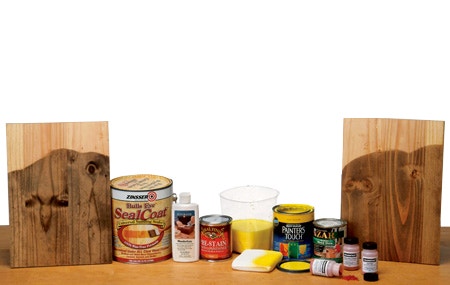Applying Finishes to Softwoods
Splotching and grain reversal are the two big problems that arise when traditional oil-based stains are applied to softwoods. When done properly, softwoods can be stained evenly and beautifully.
Softwoods are a boon to us woodworkers. They are cheap, or at least cheaper than most hardwoods, easy to machine, commonly available and look great. That is, they look great right up until they get splotchy when you stain them.
Softwood Characteristics
Let's be sure we're all on the same page: common softwoods include pine, cedar, spruce, hemlock, fir, cypress, larch, redwood and yew. These woods are characterized by distinct alternating bands of earlywood and latewood. The earlywood bands are softer and less dense than the latewood bands, and lighter in color.
One of the most common problems is due directly to the fact that the earlywood is more spongy and absorbs more stain than latewood. Initially, the latewood bands are somewhat darker in color than the earlywood. Apply a fairly dark stain, and the two change positions as the earlywood sucks up stain and the latewood resists it. The result, called grain reversal, shows the formerly light bands quite dark and the dark grain lighter in comparison (see the photo at the top of the article). Excess stain absorption is another bane of finishers. Apply a favorite stain for ash or maple to soft pine or spruce, and you may be surprised. Since the earlywood stripes often comprise the majority of the surface, the net result is a darker color than you had anticipated. Testing stain first on scrap samples of the softwood you use for your project will quickly show you what you'll end up with. You may or may not like both visual effects (grain reversal and excess absorption).
Splotchy Stain
While heavier stain absorption is both predictable and acceptable, splotching, another common problem, is neither. Certain woods contain pockets of higher sap concentration. These are invisible in the raw wood, but when oil-based stains are applied, they show up as random puddles of splotchy color. They are very difficult to predict and are not at all attractive. The reason these patches get darker is directly related to the solvents in the stain. The sap pockets soften with the same solvents used in oil-based stains, absorbing them in the process.
As solvent is absorbed, dissolved stain is also absorbed, making those areas darker. This is problematic with oil-based stains containing dye as well as pigment, since dye is more easily absorbed than pigment. Consequently, some water-based stains, and even some 100 percent pigmented stains, are less prone to splotching.
Wood Conditioner
Probably the easiest, and most common, fix for these problems is wood conditioner. Most every manufacturer that makes oil-based stain also makes a wood conditioner designed to prevent splotching; however, because of the way it works, it also reduces excess stain absorption, which in turn helps minimize the photonegative effect. Typically, oil-based wood conditioner is a mixture of common stain solvents and a small amount of clear resin. Think of conditioner as clear stain, and you'll be close.
The instructions will tell you to flood it onto the raw, sanded wood liberally, then wipe it all off. The important thing is to stain while the wood is still wet with conditioner. Allowing it to dry before staining will decrease its effectiveness. Areas prone to splotch absorb the conditioner but not excess stain. No more splotch! In essence, you have pre-stained the wood with colorless stain. Because of that, the end result is that the stain will be less intense than if you had applied it to untreated wood. To get around this, choose a darker stain to begin with.
Pre-sealing
With conditioner, you stain while the wood is wet, but when pre-sealing, you must wait to stain until the sealer is dry. As with conditioner, pre-sealing will both eliminate splotching and minimize grain reversal and excess stain absorption. It will also leave the wood lighter in color. My favorite pre-sealer is Zinsser SealCoat™. After reducing it by half with denatured alcohol, flood it onto clean, sanded wood, and wipe it off immediately. Stain the wood when the SealCoat has dried.
Exceptions to the Rule/strong>
If you don't mind grain reversal and want richer, darker staining, you can get that while avoiding splotching with two stain options. Water-soluble dyes color richly and more uniformly and are not prey to splotching problems. That's because they contain no solvents to soften the sap pockets. However, be cautious with pre-mixed liquid dyes: they may contain a little solvent. Powdered dyes that mix only with water are the best bet in this case. The other interesting alternative is stain made from latex paint. Take any color of latex wall paint, mix it with equal parts of water, and apply it like a stain, flooding it on and wiping it off. You'll find that it, too, eliminates splotch while coloring evenly and, since you can have it custom mixed, it comes in every color imaginable.
Keep the inspiration coming!
Subscribe to our newsletter for more woodworking tips and tricks




